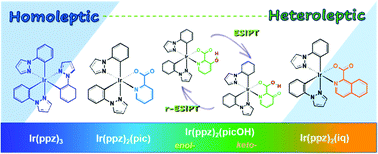Influence of picolinate ancillary ligands on unique photophysical properties of Ir(ppz)2(LX)†
Abstract
Homoleptic fac-Ir(ppz)3 (ppz = phenylpyrazole) and a series of heteroleptic Ir(ppz)2(LX) complexes consisting of picolinic acid (pic), 3-hydroxypicolinic acid (picOH), and isoquinolinecarboxylic acid (iq) as ancillary ligands (LX) were synthesised to investigate the influence of the ancillary ligands on the photophysical properties of the complexes. Generally, the role of the ancillary ligand is considered insignificant compared to that of the main ligand. Ir(ppz)3 showed deep-blue emission with a vibronic structure at 77 K, whereas Ir(ppz)2(LX) showed a broad and red-shifted emission. Theoretical calculations of the molecular orbitals and energy levels were performed using density functional theory to understand the effect of the ancillary ligands on the emission changes. The 3MLCTppz state was calculated to be higher than the 3MLCTLX state. Therefore, interligand energy transfer (ILET) between the main and ancillary ligands can occur exothermically in the triplet state. The dynamics of the ILET process were monitored directly using a femtosecond time-resolved transient absorption (TA) spectroscopic technique. The 3MLCTppz state was generated upon excitation at 290 nm, and the intensity of the TA band related to the 3MLCTppz state decreased as the time delay increased. Concurrently, the TA band related to the 3MLCTLX state intensified. On the other hand, no further changes in the TA spectra were observed upon direct excitation of the 3MLCTLX state at 420 nm. In contrast with other Ir(ppz)2(LX) complexes, Ir(ppz)2(picOH) produced long-lived TA species, attributed to excited-state intramolecular proton transfer of the picOH ligand in the excited singlet state.



 Please wait while we load your content...
Please wait while we load your content...